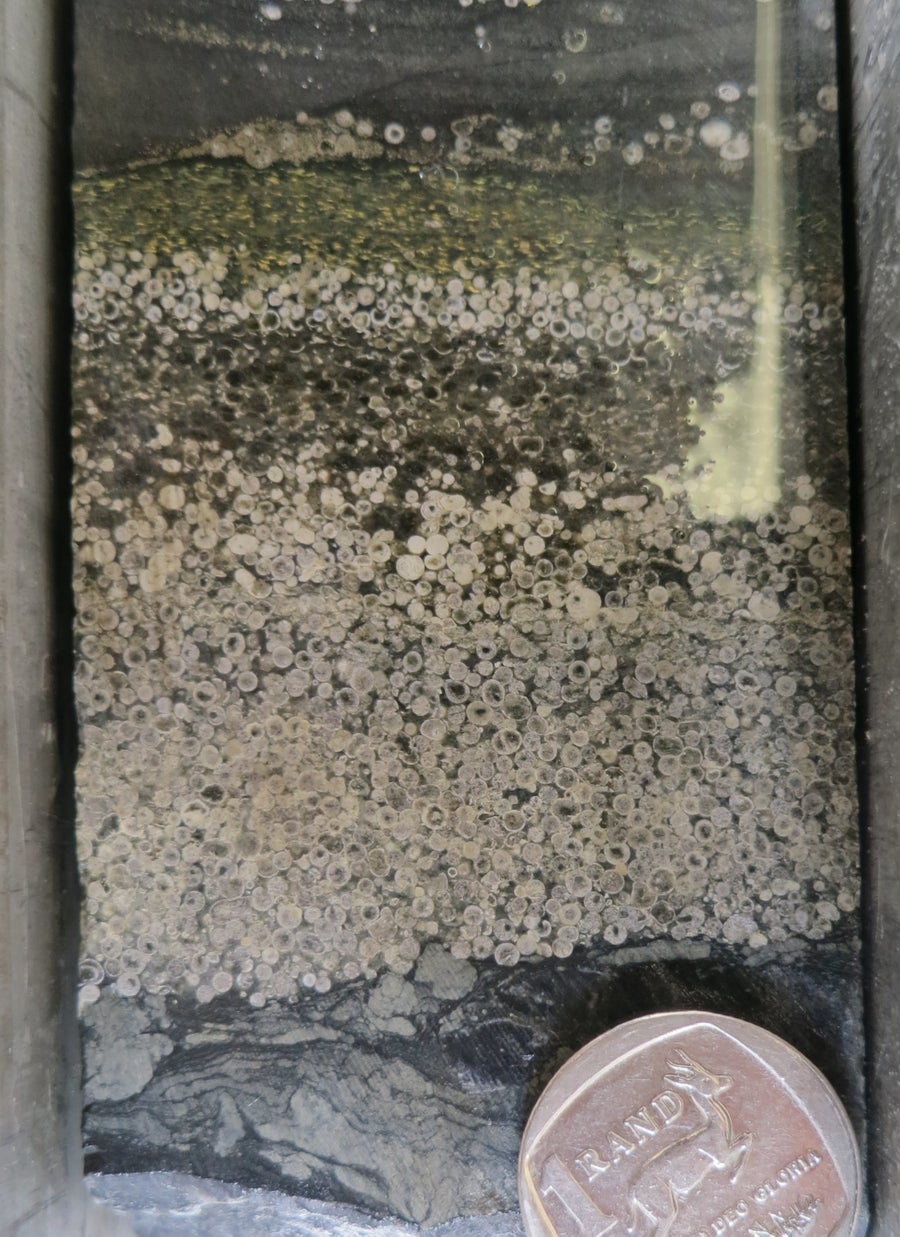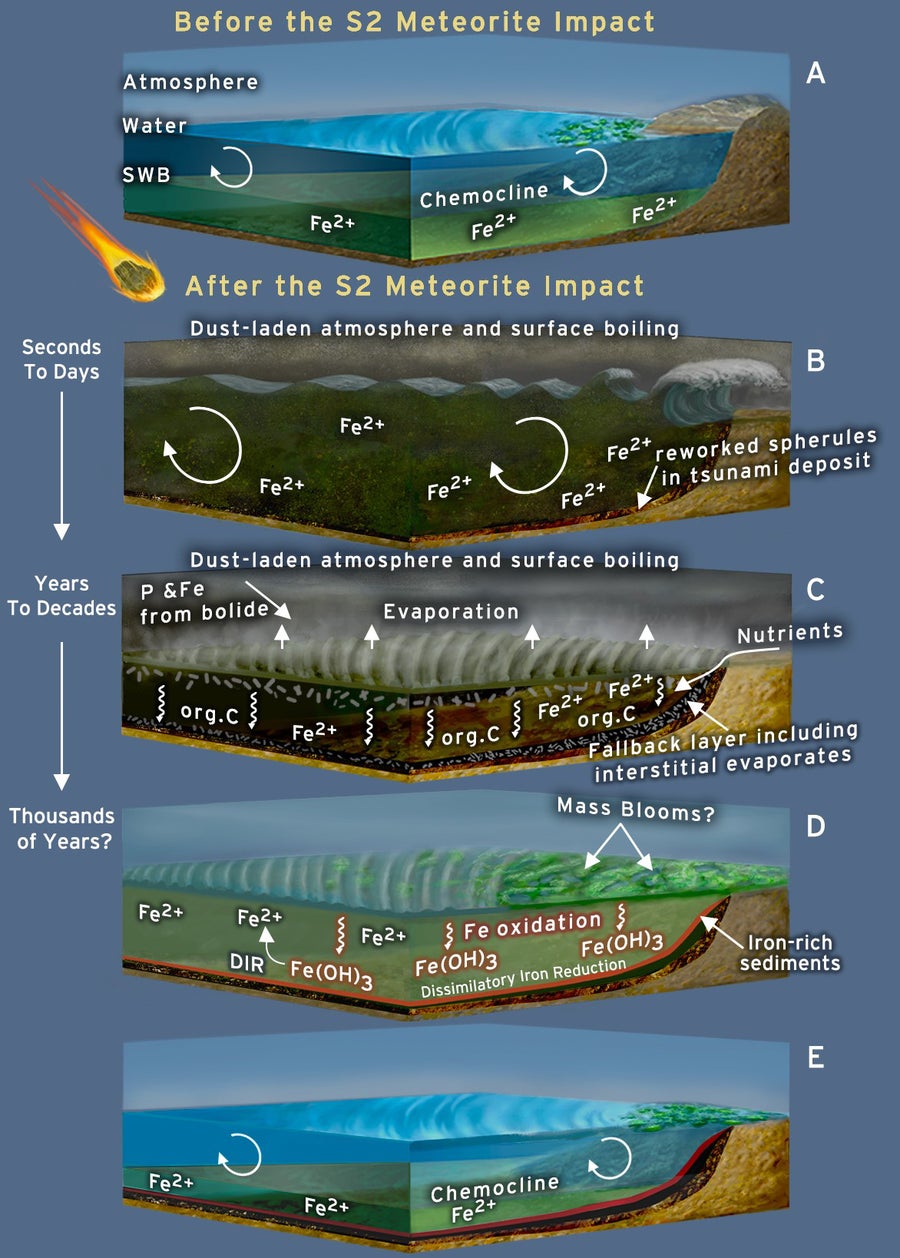Sixty-six million years ago a 10-kilometer-wide space rock fell out of the sky over what is now the Yucatán Peninsula in the Gulf of Mexico. When it hit Earth, it blew a Maryland-sized hole in the crust, igniting global firestorms and killing off some 75 percent of species. For the dinosaurs it drove to extinction, the event was effectively the end of the world. But from the ashes survivors arose—our mammalian ancestors—beginning a vibrant new era in Earth’s history. Today this catastrophic impact is considered a cosmic act of creative destruction, one without which we humans would not exist.
Yet the event’s infamous impactor was nothing compared with the asteroid that struck Earth 3.26 billion years ago, amid what scientists call the Archean eon of our planet’s 4.5-billion-year history. The Archean space rock in that impact, dubbed “S2,” was 50 to 200 times larger—big enough to blast at least 10,000 cubic kilometers of vaporized rock into the skies that then recondensed into molten droplets and rained back to Earth. Unsurprisingly, those circumstances would have been “really disastrous for early life,” says Nadja Drabon, a geologist at Harvard University. But her latest research suggests that—much like the more celebrated dino-killing space-rock impact—this vastly greater and more ancient collision also had an upside, giving Earth’s early biosphere a powerful boost.
“What we found was really stunning,” Drabon says. Working alongside several colleagues, her scrutiny of rock layers in South Africa showed that besides generating world-burning volumes of vaporized rock, the S2 impact triggered massive tsunamis and boiled away the ocean’s uppermost layer. But it also pumped phosphorus and other bioessential elements into the world’s nutrient-starved seas—triggering a bloom of life.
On supporting science journalism
If you’re enjoying this article, consider supporting our award-winning journalism by subscribing. By purchasing a subscription you are helping to ensure the future of impactful stories about the discoveries and ideas shaping our world today.
And although the dino-killer impact left behind a multimillion-year wake of ecological devastation, the dire aftereffects from this much bigger collision were too short-lived to show up in chemical analyses of the rock layers, Drabon says.
Conditions were awful “for a couple of years, maybe a few decades,” she says. “But then life would just bounce back really rapidly.” Her new study, published today in the Proceedings of the National Academy of Sciences USA, suggests that giant impacts had an even greater influence on Earth’s early biosphere than previously appreciated—and that our planet’s Archean denizens were much more resilient to this sort of shock than current life would be today.
An Unrecognizable Earth
If you flew over our planet just before the S2 impact more than three billion years ago, it would have looked very different than it does today.
“Earth was largely a water world,” with only a few volcanoes and larger islands rising above the ocean surface, says Andrew Knoll, a geobiologist at Harvard, who collaborated with Drabon on the new study. The world’s oceans may have contained twice as much water as they do in the present because the planet’s interior had not yet cooled down enough to absorb as much moisture as it now holds.
Without large continents eroding and sending minerals down rivers, the ocean was starved of critical nutrients such as phosphorus, copper, molybdenum and nickel. The atmosphere and ocean alike contained almost no free oxygen—the element that now makes up more than 20 percent of our planet’s air and sustains its animals, plants and fungi. Earth probably harbored only 1 or 2 percent the amount of life that it does today, Knoll says—all in the form of single-celled microbes.
Part of that sparse biome was powered by a primitive form of photosynthesis in which microbes used sunlight to pluck electrons from iron dissolved in seawater—allowing them to convert carbon dioxide into sugars. But the top layers of the oceans, where light was available, held only trace amounts of iron—making it challenging for even these hardy critters to eke out a living. Those oceans were “biological deserts,” Drabon says—which is why experts have so often imagined that the early Earth was a quiet, boring place.

Spherules from an Archean impact layer, with a coin used for scale. Formed from molten debris that rained out from asteroid strikes, thick beds of these tiny orbs in Archean rocks are direct evidence for catastrophic impact events in Earth’s early history.
Geological discoveries changed that view dramatically in the late 1980s and 1990s. In the Archean strata of South Africa, for instance, geologists Donald Lowe and Gary Byerly, now at Stanford University and Louisiana State University, respectively, found mineral orbs the size of sand grains crowded into at least eight layers of rock. These tiny “spherules” turned out to be solidified droplets of molten rock that rained down after a barrage of massive impact events. The craters from those impacts would have long since eroded away—but the thick layers of spherules showed they had nonetheless happened and did so with astonishing frequency. Based on their studies of the layers, Lowe and Byerly estimated that between 3.5 billion and 3.2 billion years ago, an object larger than the dino killer struck Earth at least once every 15 million years—far more often than today. Some of those asteroids, they surmised, might have been up to 350 times as massive as the dino killer.
From Boiling Pot to Paradise
Drabon, a former graduate student of Lowe’s, wondered how these quite literally earth-shattering collisions affected the Archean biosphere. She spent years collecting rocks from a few meters directly above and below the impact layer of one of those famous events: the aforementioned S2. Both sets of rocks were of the sort that had formed from sediments deposited on shallow coastal seafloors near some of the rare pieces of land. The rocks below the impact layer, predating the cataclysm, were filled with fine black layers of ancient organic carbon—the remains of gooey mats of microbes that flourished on the seafloor before being buried, squished and cooked by mundane geological processes. Those calm, flat layers probably accumulated over thousands of years. What lay directly above them happened far more quickly.
The layer of spherules, as tall in some places as several stacked bed mattresses, was scrambled with sand and pebbles, marking a series of tsunamis that raked and mixed the seafloor in the hours after the impact. Thick layers of petrified mud surmounted this impact debris, presumably formed across days or weeks as fine-grained silt kicked up by the waves settled to the seabed. Atop that mud was something that fascinated Drabon: tiny hexagonal salt crystals deposited by the sudden evaporation of briny seawater. The crystals were a sure sign that the impact had “really heated the surface and started boiling off some of the [ocean] water,” Drabon says.
She, Knoll and her other co-authors (including Lowe) argue that anywhere from a few meters to a few tens of meters of water were flash heated into steam. If that indeed happened, it would have killed “a whole lot of bacteria,” Knoll says. And debris thrown into the atmosphere would have blotted out the sun for months or years—making life much more difficult for any surviving photosynthetic microbes.
But things would have calmed down quickly.
Several meters above the impact layer, the rocks are once again filled with black, carbon-rich microbial layers, perhaps even more densely packed than the ones below—showing that “life probably bloomed after the impact,” Drabon says.
She and her team propose such blooms were driven by several factors. The rock layers above the impact contain high levels of phosphorus—a critical nutrient used in biology to manufacture everything from DNA to cell membranes. They estimate that the S2 asteroid could have delivered 360 billion metric tons of extraterrestrial phosphorus into Earth’s famished oceans. Even more of the element would have flowed into the seas via voluminous amounts of rock and silt that eroded from tsunami-lashed islands.

A schematic illustration showing the environmental disruption—and subsequent recovery—associated with a giant asteroid impact some 3.26 billion years ago. After a chaotic period in which impact-ejected dust darkened the skies and tsunamis lashed the boiling seas, nutrients released by the tumult fueled life’s resurgence.
The microbial layers above the impact are also cluttered with a rusty-red iron mineral called siderite, presumably formed from iron-rich waters churned up from the depths by turbulent tsunamis. This influx would have supercharged iron-dependent photosynthetic bacteria that were already flush with impact-delivered phosphorus, further fueling a bloom.
Drabon also examined the ratios of heavy and light carbon isotopes, or atoms of carbon with different atomic masses, in the dark microbial layers above and below the impact. This can provide clues about the types of organisms that were present—because different types of life absorb the heavy and light carbon isotopes at different rates. It revealed something important.
“We see a shift in the carbon isotopes,” Drabon says, indicating that the mix of microbes changed after the impact. “We have a new dominant metabolism” in the ocean, she says—and it likely reflected an increase in the microbes that used iron to generate energy, either through photosynthesis or other pathways.
Microbe vs. Mammoth
This new evidence that life bloomed following the S2 impact “is a really interesting find,” says Alexandra Davatzes, a geologist at Temple University, who studies Archean impacts. She points out that other major disruptions in Earth’s environment have also cranked up the biosphere, such as the “Snowball Earth” events thought to have occurred 700 million and 635 million years ago. During those events, glaciers spread across much of the world’s surface and probably exterminated plenty of life. But when the ice finally retreated, it dumped vast amounts of nutrient-rich, glacially pulverized rock into the ocean to power a biological rebound.
Eva Stüeken, a geobiologist who studies the Archean Earth at the University of St. Andrews in Scotland, believes that Drabon’s research could lead to further discoveries.
“There are certainly many [impact] events that we have missed,” she says. After all, no earthly impact craters from that time are known to have endured to the present day. And the spherule layers that these collisions sprinkled over our planet are far from guaranteed for preservation in such old rocks. But as evidence for more previously unknown impacts is found, it could increase our appreciation for how these events not only grievously harmed Earth’s biosphere but also helped to heal those wounds.
And Stüeken wonders whether S2 and other giant impacts also fertilized life in another way, one beyond what Drabon has suggested. The fiery plunges of incoming asteroids could have pulled an additional critical nutrient, nitrogen, out of the atmosphere—delivering it into the ocean in chemically reactive forms that microbes could absorb. “That’s something I would be excited to explore,” she says.
Simone Marchi, a planetary scientist at the Southwest Research Institute in Boulder, Colo., sees an important lesson in the S2 impact. There is an “interesting interplay,” he says, between an asteroid impact and the type of life that is present when it occurs. Microbes, unlike brontosaurs or mammoths, can survive extreme heat, dehydration and radiation by forming cysts or spores that persist for years. And microorganisms collectively have superior resilience to environmental disruptions in myriad other ways. If one out of a billion microbes survives, it can replenish the entire population because it grows and divides so quickly.
“Life at the time was capable of taking the punch” from the S2 impact, Marchi says. But what if this much larger asteroid had hit Earth 66 million years ago, after flowers, trees, dinosaurs, mammals, fish and other complex life had evolved?
“For this type of event, only simple life could have survived,” he says. Rather than weeding out the dinosaurs but leaving mammals, birds and fish intact, the impact could have obliterated all plants and animals. “It would be a complete reset of life,” Marchi says, “back to the bacterial level.”
